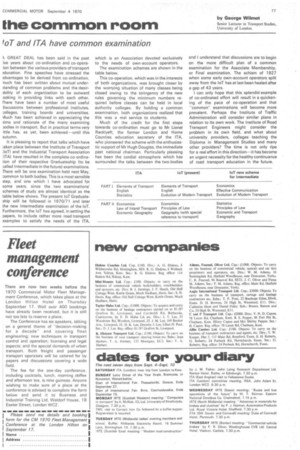the common room
Page 79

If you've noticed an error in this article please click here to report it so we can fix it.
by George Wilmot
foT and ITA have common examination
1. GREAT DEAL has been said in the past ive years about co-ordination and co-operaion between the various providers of transport education. Fine speeches have stressed the idvantages to be derived from co-ordination, much has been written about mutual under;tending of common problems and the desir3bility of each organization to be outward ooking in providing links with each other. Ihere have been a number of most useful iiscussions between professional institutes, ;olleges, training boards and universities. Ouch has been achieved in appreciating the urns and rationale of the many examining )odies in transport. But in practical terms very ittle has, as yet, been achieved—until this 3utumn.
It is pleasing to report that talks which have :aken place between the Institute of Transport 10T) and the Industrial Transport Association ITAI have resulted in the complete co-ordinaeon of their respective Graduateship (to be 3alled Intermediate in the future) examinations. There will be one examination held next May, 2ommon to both bodies. This is a most sensible step, and one which I have advocated for some years, since the two examinations' schemes of study are almost identical as the table below shows. The present loT Graduateship will be followed in 1970/71 and later the new Intermediate examination of the loT. Furthermore, the loT has agreed, in setting the papers, to include rather more road transport examples to satisfy the needs of the ITA,
which is an Association devoted exclusively to the needs of own-account operators.
The examination schemes are shown in the table below.
This co-operation, which was in the interests of both organizations, was brought closer by the worrying situation of many classes being closed owing to the stringency of the new rules governing the minimum numbers required before classes can be held in local authority colleges. By holding a common examination, both organizations realized that this was a real service to students.
Much of the credit for the first steps towards co-ordination must go to Mr Lionel Racklyeft, the former London and Home Counties education secretary of the ITA, who pioneered the scheme with the enthusiastic support of Mr Hugh Douglas, the immediate past national chairman. Particularly pleasing has been the cordial atmosphere which has surrounded the talks between the two bodies and I understand that discussions are to begin on the more difficult plan of a common examination for the Associate Membership, or Final examination. The schism of 1927 when some early own-account operators split away from the loT has at last been healed after a gap of 43 years, I can only hope that this splendid example of co-ordinated effort will result in a quickening of the pace of co-operation and that "common" examinations will become more prevalent. Perhaps the Institute of Traffic Administration will consider similar plans in relation to its own work. The Institute of Road Transport Engineers might consider the problem in its own field, and what about university providers, colleges teaching the Diploma in Management Studies and many other providers? The time is not only ripe for a real effort in this direction—it has become an urgent necessity for the healthy continuance of road transport education in the future.




























































































































